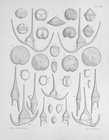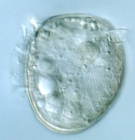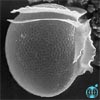
| Home | | Literature | | Log in |
| Diatoms | | Haptophytes | | Dinoflagellates | | Raphidophyceans | | Dictyochophyceans | | Pelagophyceans | | Cyanobacteria | | Greylist | | Harmful non-toxic |
WoRMS taxon detailsPhalacroma rotundatum (Claparéde & Lachmann) Kofoid & J.R.Michener, 1911
156505 (urn:lsid:marinespecies.org:taxname:156505)
accepted
Species
Dinophysis rotundata Claparède & Lachmann, 1859 · unaccepted (synonym)
Dinophysis rotundata Levander, 1894 · unaccepted (synonym)
Dinophysis whittingae Balech, 1971 · unaccepted (misspelling)
Dinophysis whittingiae Balech, 1971 · unaccepted (synonym)
Prodinophysis rotundata (Claparéde & Lachmann) Balech, 1944 · unaccepted (synonym)
Prodinophysis rotundatum (Claparéde & Lachmann) Balech, 1944 · unaccepted (synonym)
marine
(of Dinophysis rotundata Claparède & Lachmann, 1859) Claparède E. & Lachmann J. (1858). Etudes sur les Infusoires et les Rhizopodes. <em>Mém. Inst. Genev.</em> 5, 6: 489 pp. [details]
Type locality contained in North Sea
type locality contained in North Sea [from synonym] [view taxon] [details]
LSID urn:lsid:algaebase.org:taxname:45000
LSID urn:lsid:algaebase.org:taxname:45000 [details] Description Cells medium-sized (36–56 μm in length and 36–43 μm in dorso-ventral depth), regularly oval in lateral view and...
Description Cells medium-sized (36–56 μm in length and 36–43 μm in dorso-ventral depth), regularly oval in lateral view and broadly rounded in lateral view with convex ventral and dorsal margins. Absence of chloroplasts (heterotrophic species). Left sulcal list (LSL) extends over 1/2 to 3/4 of cell length. The greatest dorso-ventral width (depth) is between the base of the second and third rib of the LSL. Thecal surface covered with poroids and scattered pores. [details] Distribution cosmopolitan; warm and cold waters.
Distribution cosmopolitan; warm and cold waters. [details]
Guiry, M.D. & Guiry, G.M. (2024). AlgaeBase. World-wide electronic publication, National University of Ireland, Galway (taxonomic information republished from AlgaeBase with permission of M.D. Guiry). Phalacroma rotundatum (Claparéde & Lachmann) Kofoid & J.R.Michener, 1911. Accessed through: World Register of Marine Species at: https://marinespecies.org/aphia.php?p=taxdetails&id=156505 on 2024-09-19
Date action by 2007-10-17 15:07:21Z changed db_admin Copyright notice: the information originating from AlgaeBase may not be downloaded or replicated by any means, without the written permission of the copyright owner (generally AlgaeBase). Fair usage of data in scientific publications is permitted.
original description
(of Dinophysis rotundata Claparède & Lachmann, 1859) Claparède E. & Lachmann J. (1858). Etudes sur les Infusoires et les Rhizopodes. <em>Mém. Inst. Genev.</em> 5, 6: 489 pp. [details]
context source (Deepsea) Intergovernmental Oceanographic Commission (IOC) of UNESCO. The Ocean Biogeographic Information System (OBIS), available online at http://www.iobis.org/ [details] context source (HKRMS) Lam CWY. & Ho KC. (1988). Phytoplankton characteristics of Tolo Harbour. In: Morton B, editor. Asian Marine Biology 6. pp 5-18. Hong Kong University Press, Hong Kong. [details] context source (Schelde) Maris, T.; Beauchard, O.; Van Damme, S.; Van den Bergh, E.; Wijnhoven, S.; Meire, P. (2013). Referentiematrices en Ecotoopoppervlaktes Annex bij de Evaluatiemethodiek Schelde-estuarium Studie naar “Ecotoopoppervlaktes en intactness index”. <em>Monitor Taskforce Publication Series, 2013-01. NIOZ: Yerseke.</em> 35 pp. (look up in IMIS) [details] basis of record Guiry, M.D. & Guiry, G.M. (2024). AlgaeBase. <em>World-wide electronic publication, National University of Ireland, Galway.</em> searched on YYYY-MM-DD., available online at http://www.algaebase.org [details] basis of record Horner, R. A. (2002). A taxonomic guide to some common marine phytoplankton. <em>Biopress Ltd. Bristol.</em> 1-195. [details] additional source Martin, J. L.; LeGresley, M. M. ; Strain, P. M. (2001). Phytoplankton monitoring in the Western Isles region of the Bay of Fundy during 1997-98. <em>Canadian Technical Report of Fisheries and Aquatic Sciences 2349.</em> 4: 1-85. [details] additional source Scott, F.J.; Marchant, H.J. (Ed.). (2005). Antarctic marine protists. <em>Australian Biological Resources Study: Canberra.</em> ISBN 0-642-56835-9. 563 pp., available online at http://its-db.aad.gov.au/proms/pubn/pubshow.asp?pub_id=12140 [details] additional source Steidinger, K. A., M. A. Faust, and D. U. Hernández-Becerril. 2009. Dinoflagellates (Dinoflagellata) of the Gulf of Mexico, Pp. 131–154 in Felder, D.L. and D.K. Camp (eds.), Gulf of Mexico–Origins, Waters, and Biota. Biodiversity. Texas A&M Press, College [details] additional source Moestrup, Ø., Akselman, R., Cronberg, G., Elbraechter, M., Fraga, S., Halim, Y., Hansen, G., Hoppenrath, M., Larsen, J., Lundholm, N., Nguyen, L. N., Zingone, A. (Eds) (2009 onwards). IOC-UNESCO Taxonomic Reference List of Harmful Micro Algae., available online at http://www.marinespecies.org/HAB [details] additional source Balech, E. (1962). Tintinnoinea y Dinoflagellata del Pacífico según material de las expediciones Norpac y Downwind del Instituto Scripps de Oceanografía. <em>Rev. Mus. Arg. Cs. Nat. “B. Rivadavia”, C. Zool.</em> 7(1): 1-253, 26 pl. [details] Available for editors additional source Chang, F.H.; Charleston, W.A.G.; McKenna, P.B.; Clowes, C.D.; Wilson, G.J.; Broady, P.A. (2012). Phylum Myzozoa: dinoflagellates, perkinsids, ellobiopsids, sporozoans, in: Gordon, D.P. (Ed.) (2012). New Zealand inventory of biodiversity: 3. Kingdoms Bacteria, Protozoa, Chromista, Plantae, Fungi. pp. 175-216. [details] additional source Steidinger, K.A.; Tangen, K. (1997). Dinoflagellates. pp. 387-584. In: C.R. Tomas (ed.) (1997). Identifying Marine Phytoplankton. Academic Press: San Diego, CA [etc.] (USA). ISBN 0-12-693018-X. XV, 858 pp., available online at http://www.sciencedirect.com/science/article/pii/B9780126930184500057 [details] additional source Guiry, M.D. & Guiry, G.M. (2024). AlgaeBase. <em>World-wide electronic publication, National University of Ireland, Galway.</em> searched on YYYY-MM-DD., available online at http://www.algaebase.org [details] additional source Integrated Taxonomic Information System (ITIS). , available online at http://www.itis.gov [details] additional source Tomas, C.R. (Ed.). (1997). Identifying marine phytoplankton. Academic Press: San Diego, CA [etc.] (USA). ISBN 0-12-693018-X. XV, 858 pp., available online at http://www.sciencedirect.com/science/book/9780126930184 [details]  Present Present  Present in aphia/obis/gbif/idigbio Present in aphia/obis/gbif/idigbio  Inaccurate Inaccurate  Introduced: alien Introduced: alien  Containing type locality Containing type locality
From editor or global species database
LSID urn:lsid:algaebase.org:taxname:45000 [details]From regional or thematic species database
Description Cells medium-sized (36–56 μm in length and 36–43 μm in dorso-ventral depth), regularly oval in lateral view and broadly rounded in lateral view with convex ventral and dorsal margins. Absence of chloroplasts (heterotrophic species). Left sulcal list (LSL) extends over 1/2 to 3/4 of cell length. The greatest dorso-ventral width (depth) is between the base of the second and third rib of the LSL. Thecal surface covered with poroids and scattered pores. [details]Harmful effect HPLC-FD analysis of one sample of picked cells of Japanese strains of D. rotundata found it containing DTX1 (101 pg/cell)(Lee et al. 1989). No toxins detected in HPLC-FD analyses of dense blooms of P. rotundatum (as Dinophysis rotundata) from eastern Canada (Cembella 1989) and Italy (Caroppo et al. 1999). No toxins in picked cells analyzed by LC-MS in Japan (Suzuki et al. 2009). When P. rotundatum was found co-occurring with toxic species of Dinophysis (D. acuminata, D. acuta, D. norvegica, D. caudata), LC-MS analyses of picked cells showed either small amounts of the same toxins (OA, DTXs, PTXs) present in the co-occurring Dinophysis species or no toxins at all (Miles et al. 2004; González-Gil et al. 2011). Miles et al. (2004) found the same toxins in 3 heterotrophic species of Protoperidinium co-occurring with the same multispecific bloom (D. acuminata, D. acuta, D. norvegica and P. rotundatum). There is growing suspicion that P. rotundatum is not a toxin-producer de novo, but may contain DSP toxins and act as a vector after feeding on tintinnids who preyed on toxic Dinophysis (reviewed in González-Gil et al. 2011). [details] From other sources
Diet general for group: both heterotrophic (eat other organisms) and autotrophic (photosynthetic) [details]Distribution cosmopolitan; warm and cold waters. [details] Habitat pelagic [details] Importance General: known for producing dangerous toxins, particularly when in large numbers, called "red tides" because the cells are so abundant they make water change color. Also they can produce non-fatal or fatal amounts of toxins in predators (particularly shellfish) that may be eaten by humans. [details] Predators marine microorganisms and animal larvae [details] Reproduction general for group: both sexual and asexual [details]
PlanktonNet Image
PlanktonNet Image (from synonym Dinophysis rotundata Claparède & Lachmann, 1859) Published in AlgaeBase  (from synonym Dinophysis rotundata Claparède & Lachmann, 1859) (from synonym Dinophysis rotundata Claparède & Lachmann, 1859)Published in AlgaeBase  Published in AlgaeBase  (from synonym Dinophysis whittingiae Balech, 1971) (from synonym Dinophysis whittingiae Balech, 1971)Published in AlgaeBase  (from synonym Prodinophysis rotundatum (Claparéde & Lachmann) Balech, 1944) (from synonym Prodinophysis rotundatum (Claparéde & Lachmann) Balech, 1944)Published in AlgaeBase  (from synonym Prodinophysis rotundata (Claparéde & Lachmann) Balech, 1944) (from synonym Prodinophysis rotundata (Claparéde & Lachmann) Balech, 1944)To Barcode of Life (2 barcodes) (from synonym Dinophysis rotundata Levander, 1894) To Barcode of Life (2 barcodes) (from synonym Dinophysis rotundata Claparède & Lachmann, 1859) To Biodiversity Heritage Library (1 publication) (from synonym Dinophysis whittingae Balech, 1971) To Biodiversity Heritage Library (4 publications) To Biodiversity Heritage Library (60 publications) (from synonym Dinophysis rotundata Levander, 1894) To Biodiversity Heritage Library (60 publications) (from synonym Dinophysis rotundata Claparède & Lachmann, 1859) To Dyntaxa (from synonym Dinophysis rotundata Claparède & Lachmann, 1859) To European Nucleotide Archive, ENA (Dinophysis whittingae) (from synonym Dinophysis whittingae Balech, 1971) To European Nucleotide Archive, ENA (Phalacroma rotundatum) To GenBank (1 nucleotides; 0 proteins) (from synonym Dinophysis whittingae Balech, 1971) To GenBank (17 nucleotides; 2 proteins) (from synonym Prodinophysis rotundatum (Claparéde & Lachmann) Balech, 1944) To GenBank (17 nucleotides; 2 proteins) To GenBank (17 nucleotides; 2 proteins) (from synonym Prodinophysis rotundata (Claparéde & Lachmann) Balech, 1944) To PESI To PESI (from synonym Dinophysis rotundata Claparède & Lachmann, 1859) To ITIS |






